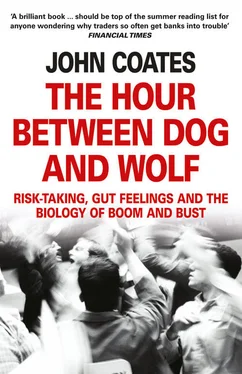The 1990s were a decade ripe for such research. They gave us the folly of the dot.com bubble as well as the phrase that best described it – ‘irrational exuberance’. This term, first used by Alan Greenspan in a speech delivered in Washington in 1996 and subsequently given wide currency by the Yale economist Robert Shiller, means much the same thing as an older one, ‘animal spirits’, coined in the 1930s by Keynes when he gestured towards some ill-defined and non-rational force animating entrepreneurial and investor risk-taking. But what are animal spirits? What is exuberance?
In the nineties, one or two people did suggest that irrational exuberance might be driven by a chemical. In 1999 Randolph Nesse, a psychiatrist at the University of Michigan, bravely speculated that the dot.com bubble differed from previous ones because the brains of many traders and investors had changed – they were under the influence of now widely prescribed antidepressant drugs, such as Prozac. ‘Human nature has always given rise to booms and bubbles followed by crashes and depressions,’ he argued. ‘But if investor caution is being inhibited by psychotropic drugs, bubbles could grow larger than usual before they pop, with potentially catastrophic economic and political consequences.’ Other observers of Wall Street, following a similar line of thought, pointed the finger at another culprit: the increasing use of cocaine among bankers.
These rumours of cocaine abuse, at least among traders and asset managers, were mostly exaggerated. (Members of the sales force, especially the salesmen responsible for taking clients out to lap-dancing bars till the wee hours of the morning, may have been another matter.) As for Nesse, his comments received some humorous coverage in the media, and when he spoke at a conference organised by the New York Academy of Sciences a year later he seemed to regret making them. But I thought he was on the right track; and to me his suggestion pointed to another possibility – that traders’ bodies were producing a chemical, apparently narcotic, that was causing their manic behaviour. What was this bull-market molecule?
I came across a likely suspect purely by chance. During the later years of the dot.com era I was fortunate enough to observe some fascinating research being conducted in a neuroscience lab at Rockefeller University, a research institution hidden on the Upper East Side of Manhattan, where a friend, Linda Wilbrecht, was doing a Ph.D. I was not at Rockefeller in any formal capacity, but when the markets were slow I would jump in a taxi and run up to the lab to observe the experiments taking place, or to listen to afternoon lectures in Caspary Auditorium, a geodesic dome set in the middle of that vine-clad campus. Scientists in Linda’s lab were working on what is called ‘neurogenesis’, the growth of new neurons. Understanding neurogenesis is in some ways the Holy Grail of the brain sciences, for if neurologists could figure out how to regenerate neurons they could perhaps cure or reverse the damage of neuro-degenerative diseases such as Alzheimer’s and Parkinson’s. Many of the breakthroughs in the study of neurogenesis have taken place at Rockefeller.
There was another area of the neurosciences where Rockefeller had made a historic contribution, and that was in research on hormones, and specifically their effects on the brain. Many of the breakthroughs in this field had been made by scientists addressing very specific issues in neuroscience, but today their results may help us understand irrational exuberance, for the bull-market molecule may in fact be a hormone. And if that is the case, then by a delightful coincidence, at the very moment in the late 1990s when Wall Street was asking the question ‘What is irrational exuberance?’, uptown at Rockefeller scientists were working on the answer.
So what exactly are hormones? Hormones are chemical messengers carried by the blood from one tissue in the body to another. We have dozens of them. We have hormones that stimulate hunger and ones that tell us when we are sated; hormones that stimulate thirst and ones that tell us when it is slaked. Hormones play a central role in what is called our body’s homeostasis, the maintenance of vital signs, like blood pressure, body temperature, glucose levels, etc., within the narrow bands needed for our continued comfort and health. Most of the physiological systems that maintain our internal chemical balance operate pre-consciously, in other words without our being aware of them. For instance, we are all blissfully unaware of the Swiss-watch-like workings of the system controlling the potassium levels in our blood.
But sometimes we cannot maintain our internal balance through these silent, purely chemical reactions. Sometimes we need behaviour; sometimes we have to engage in some sort of physical activity in order to re-establish homeostasis. When glucose levels in our blood fall, for example, our bodies silently liberate glucose deposits from the liver. Soon, however, the glucose reserves burn off, and the low blood sugar communicates itself to our consciousness by means of hunger, a hormonal signal that spurs us to search for food and then to eat. Hunger, thirst, pain, oxygen debt, sodium hunger and the sensations of heat and cold, for example, have accordingly been called ‘homeostatic emotions’. They are called emotions because they are signals from the body that convey more than mere information – they also carry a motivation to do something.
It is enlightening to see our behaviour as an elaborate mechanism designed to maintain homeostasis. However, before we go too far down the path of biological reductionism, I have to point out that hormones do not cause our behaviour. They act more like lobby groups, recommending and pressuring us into certain types of activity. Take the example of ghrelin, one of the hormones regulating hunger and feeding. Produced by cells in the lining of your stomach, ghrelin molecules carry a message to your brain saying in effect, ‘On behalf of your stomach we urge you to eat.’ But your brain does not have to comply. If you are on a diet, or a religious fast, or a hunger strike, you can choose to ignore the message. You can, in other words, choose your actions, and ultimately you take responsibility for them. Nonetheless, with the passing of time the message, at first whispered, becomes more like a foghorned bellow, and can be very hard to resist. So when we look at the effects of hormones on behaviour and on risk-taking – especially financial risk-taking – we will not be contemplating anything like biological determinism. We will be engaged rather in a frank discussion of the pressures, sometimes very powerful, these chemicals bring to bear on us during extreme moments in our lives.
One group of hormones has particularly potent effects on our behaviour – steroid hormones. This group includes testosterone, oestrogen and cortisol, the main hormone of the stress response. Steroids exert particularly widespread effects because they have receptors in almost every cell in our body and brain. Yet it was not until the 1990s that scientists began to understand just how these hormones influence our thinking and behaviour. Much of the work that led to this understanding was conducted in the lab of Bruce McEwen, a renowned professor at Rockefeller. He and his colleagues, including Donald Pfaff and Jay Weiss, were among the first scientists not only to map steroid receptors in the brain but also to study how steroids affect the structure of the brain and the way it works.
Before McEwen began his research, scientists widely believed that hormones and the brain worked in the following way: the hypothalamus, the region of the brain controlling hormones, sends a signal through the blood to the glands producing steroid hormones, be they testes, ovaries or adrenal glands, telling them to increase hormone production. The hormones are then injected into the blood, fan out across the body, and exert their intended effects on tissues such as heart, kidneys, lungs, muscles, etc. They also make their way back to the hypothalamus itself, which senses the higher hormone levels and in response tells the glands to stop producing the hormone. The feedback between hypothalamus and hormone-producing gland works much like a thermostat in a house, which senses cold and turns on the heating, and then senses the warmth and turns it off.
Читать дальше











![John Bruce - The Lettsomian Lectures on Diseases and Disorders of the Heart and Arteries in Middle and Advanced Life [1900-1901]](/books/749387/john-bruce-the-lettsomian-lectures-on-diseases-and-disorders-of-the-heart-and-arteries-in-middle-and-advanced-life-1900-1901-thumb.webp)
